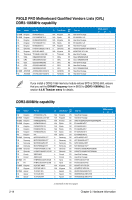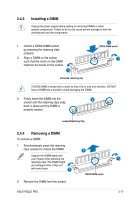Asus P5QLD PRO P5QLD PRO user's manual - Page 35
Ai Tweaker menu - windows 8
 |
View all Asus P5QLD PRO manuals
Add to My Manuals
Save this manual to your list of manuals |
Page 35 highlights
• You may install varying memory sizes in Channel A and Channel B. The system maps the total size of the lower-sized channel for the dual-channel configuration. Any excess memory from the higher-sized channel is then mapped for single-channel operation. • Always install DIMMs with the same CAS latency. For optimum compatibility, it is recommended that you obtain memory modules from the same vendor. • Due to the memory address limitation on 32-bit Windows® OS, when you install 4GB or more memory on the motherboard, the actual usable memory for the OS can be about 3GB or less. For effective use of memory, we recommend that you do any of the following: - Use a maximum of 3GB system memory if you are using a 32-bit Windows® OS. - Install a 64-bit Windows® OS when you want to install 4GB or more memory on the motherboard. • This motherboard does not support DIMMs made up of 256 megabits (Mb) chips or less. • The default memory operation frequency is dependent on its SPD. Under the default state, some memory modules for overclocking may operate at a lower frequency than the vendor-marked value. To operate at the vendormarked or at a higher frequency, see section 4.4 Ai Tweaker menu for manual memory frequency adjustment. • The memory modules may require a better cooling system to work stably under full loading (4 DIMMs) or overclocking setting. • Some old-version DDR2-800 DIMMs may not match Intel®'s On‑Die‑Termination (ODT) requirement and will automatically downgrade to run at DDR2-667. If this happens, contact your memory vendor to check the ODT value. • Due to chipset limitation, DDR2-800 with CL=4 will be downgraded to run at DDR2-667 by default setting. If you want to operate with lower latency, adjust the memory timing manually. ASUS P5QLD PRO 2-13















